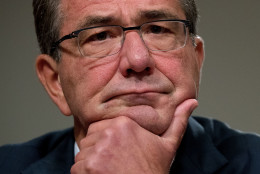defense spending
-
Congress bought itself more time to work out a fiscal 2017 budget by passing a continuing resolution, but an intractable fight remains on the defense spending front.
September 29, 2016 -
Defense Secretary Ashton Carter expressed deep displeasure with the congressional budgeting process Thursday, calling it “deplorable” that the government seems poised to begin a new fiscal year under a continuing resolution for the eighth year in a row.
September 23, 2016 -
House Armed Services Chairman Mac Thornberry says the Defense Department is already spending $6 billion it hasn't budgeted for in 2017.
July 25, 2016 -
The departments of Defense and Veterans Affairs certified to Congress that their electronic health records were finally interoperable. That was three months ago. And lawmakers aren’t satisfied with that assertion.
July 22, 2016 -
Driven by global threats and a rise in defense spending outside of the U.S., the aerospace and defense industry worldwide will see growth this year, after falling for two years. That's the assessment from Deloitte in its annual performance study. Joining me with more, Retired Air Force Gen. Chuck Wald, vice chairman and senior adviser at Deloitte, has more on Federal Drive with Tom Temin.
July 15, 2016 -
A new report from a Washington-based think tank points to an ever-widening disconnect between the size of the Defense Department’s Overseas Contingency Operations (OCO) fund and the troop levels it was originally meant to pay for.
June 15, 2016 -
The Army is a few weeks away from an experiment that aims to tackle the “use it or lose it” phenomenon that manifests itself at the end of each fiscal year in almost every government office.
June 06, 2016 -
Defense Secretary Ash Carter called the House proposal "deeply troubling," saying it would pay for additional troops and pay boosts at the expense of long-term military readiness and budget stability.
April 28, 2016 -
Katherine Blakeley, research fellow for the Center for Strategic and Budgetary Assessments, joins host Derrick Dortch to discuss her new report on the seven areas to watch in the FY 2017 defense budget. April 29, 2016
April 26, 2016 -
The U.S. military strategy for the current world: Take a given-sized ball of dough and stretch it into a wider but thinner pie crust.
February 10, 2016 -
DoD's 2017 budget includes few changes to pay and benefits, but DoD facilities and procurement take a major hit. The proposal includes an $8.1 billion reduction to acquisition programs, a $1 billion cut to new construction and severe underfunding of base maintenance.
February 10, 2016 -
Defense Secretary Ash Carter says the Obama administration's final Pentagon budget represents a turning point; high-end technologies will get more attention.
February 03, 2016 -
Defense spending seems to have a life of its own. Neither the Secretary of Defense nor experienced members of the Armed Services Committees can stem the tide of wasteful spending. That's according to Charles Tiefer, professor at the University of Baltimore law school and former soliciter and deputy general counsel for the House of Representatives. He joins Federal Drive with Tom Temin with what he sees as some of the more egregious examples of DoD waste coming up in 2016.
January 22, 2016 -
Despite lower funding levels, Defense leaders count their blessings with two years of budget certainty.
November 16, 2015 -
Testifying before the Senate Armed Services Committee, former Defense Secretary Robert Gates acknowledged the rationale for reforms which centralized big decisions within the DoD acquisition system.
October 22, 2015















